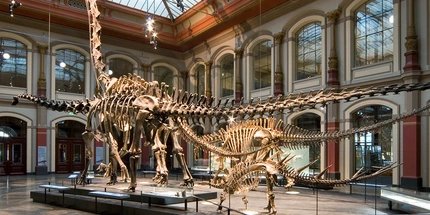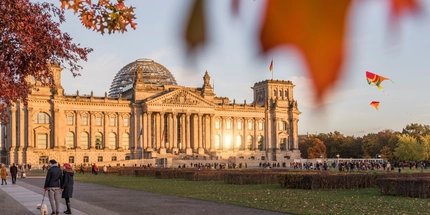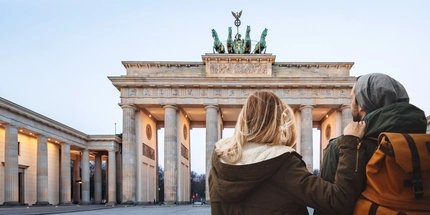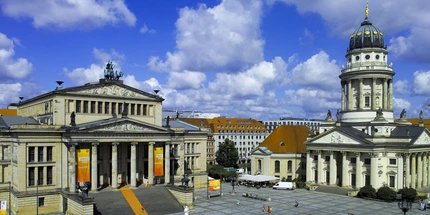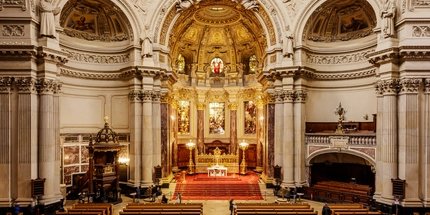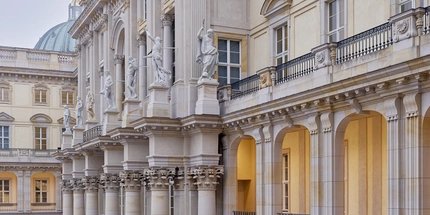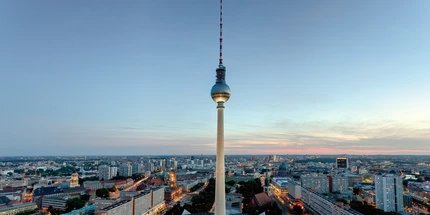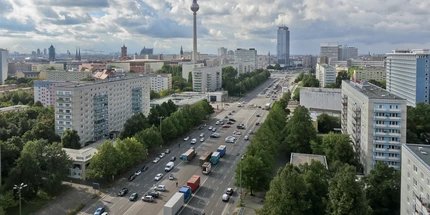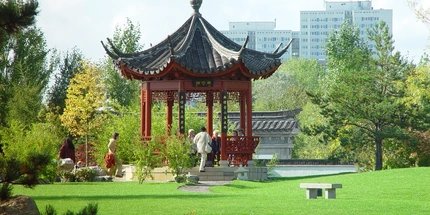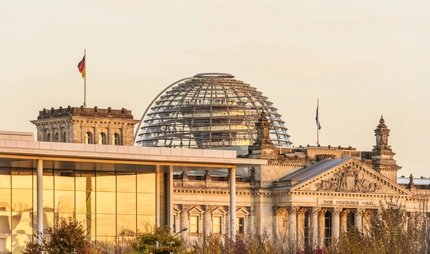
U5 – Sightseeing tour on the underground
Overview of all stops
Get on board and discover Berlin's sights quickly and conveniently with the newly expanded U5 underground line. In just 41 minutes you will be able to travel from Central Station to Berlin Hönow without changing trains.
The most important sights in Berlin's historic centre can be found in the immediate vicinity of U5 stations, located between the Reichstag and Alexanderplatz. Continuing on your journey, the U5 takes you out into the green outer districts, to Tierpark and the Gardens of the World, as well as to lesser-known places that are well worth discovering.
Infographics. U5
ABOUT BERLIN App
Find exciting stories and background information about the sights and attractions along the U5. In our free story app ABOUT BERLIN, we take you on a journey through time. Learn about unusal historical moments and take a look behind the scenes. Of course, you can also book a ticket with time slot reservation for selected sights via our app. Have a good trip!
Download now for free for iPhone and Android:


There's many stories to tell. ABOUT BERLIN.
Three new stations with exciting architecture
Previously, the U5 ran from Alexanderplatz to Hönow, but now the connection to the former U55 line between Central Station and the Brandenburg Gate has been completed and three new underground stations in Mitte connect the two lines to the new U5 line: Unter den Linden, Rotes Rathaus and Museumsinsel.
The Unter den Linden station connects this boulevard and Friedrichstrasse to Charlottenstrasse. Its design makes reference to the neighbouring Humboldt University, as its theme is the anthropocene, the geological age shaped by humans.
The Museumsinsel underground station will open on July 9. This station features a bright blue ceiling with glowing points of light, reminiscent of Friedrich Schinkel's famous stage design for Mozart's Magic Flute.
The Rotes Rathaus underground station, inspired by the historic vaulted ceiling of the medieval town hall, features an elegant black and white design.
Sights along the metro line
From the past into the future: From Central Station to Alexanderplatz
Hauptbahnhof
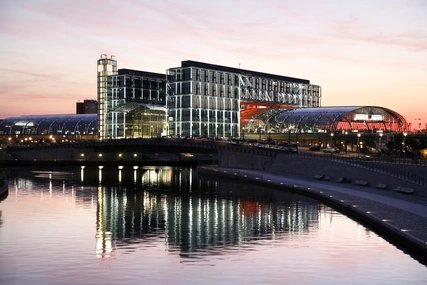
In the immediate vicinity of Central Station are two of the city's most important museums, Hamburger Bahnhof and the Museum of Natural History. In Hamburger Bahnhof you can discover contemporary art of international standing. In the renowned Museum of Natural History you can take a deep look into the workings of nature. The Futurium, on the other hand, will transport you into the future, showing you various future perspectives in an interactive way.
The Berlin Tourist Info at Central Station will provide you with useful information and you can book your hotel and buy tickets here too.
Bundestag
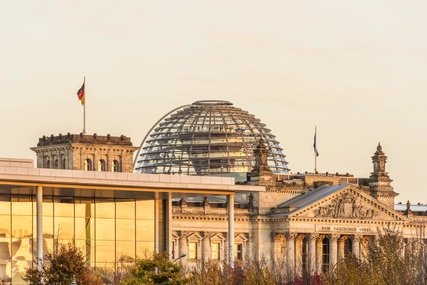
Travel one station further and you will find yourself right at the heart of German democracy. The Reichstag is the seat of the German Parliament, and you can even climb onto its roof as the glass dome and terrace are open to visitors. Opposite the Reichstag stretch a number of federal government buildings as well as the Federal Chancellery.
Brandenburger Tor

The Brandenburg Gate is not only Berlin's most important landmark, it is also a symbol of Germany's eventful history – where once it bore witness to division, today it stands for German unity. A Berlin Tourist Info point is located in the southern side wing.
The northern gatehouse houses the Raum der Stille (Room of Silence), a space where you can pause, linger in silence and spend time in contemplation. Famous people from history, sports and film are waiting for you just around the corner at Madame Tussauds, the famous wax museum.
Pariser Platz is lined with impressive buildings such as the French Embassy and the Academy of Arts.
Not far from the Brandenburg Gate, the Memorial to the Murdered Jews of Europe commemorates the victims of the Holocaust. The area with its concrete columns of varying heights is a place of commemoration and remembrance.
Just a short walk away is Potsdamer Platz, with its modern architecture, shopping malls and numerous entertainment venues such as the LEGOLAND® Discovery Centre for the young and young-at-heart.
At Leipziger Platz, the German Spy Museum takes you into the shadowy realm of the secret services, where you can undertake an interactive journey through the history of espionage.
In the historical centre of Berlin: From Unter den Linden to the Rotes Rathau
Unter den Linden is Berlin's glamorous boulevard stretching from the Brandenburg Gate to the Schlossbrücke (palace bridge) and the centre of historic Berlin with numerous magnificent buildings.
Unter den Linden

The new Unter den Linden station is located at the intersection with Friedrichstrasse, which invites you to go on a shopping spree in its classy stores. Many people consider Gendarmenmarkt, with its ensemble of the French Cathedral, the Konzerthaus and the German Cathedral, to be the most beautiful square in the city.
The Friedrichswerder Church on Werderscher Markt, built by Karl Friedrich Schinkel, is no longer a place of worship, but provides an impressive setting for sculptures from the Schinkel era.
At Bebelplatz, a memorial embedded in the ground commemorates the burning of books. The St. Hedwig Cathedral with its striking dome is currently being restored.
Steeped in tradition, the Staatsoper Unter den Linden (Berlin State Opera) looks back on over 275 years of tradition and continues to inspire audiences with its groundbreaking productions. The German Historical Museum opposite also combines the past and present in its exhibitions in the baroque Zeughaus (armoury) with a modern exhibition hall. The Neue Wache next to the museum is the central memorial to the victims of war and tyranny.
Museum Island

Museum Island is a UNESCO World Heritage Site and combines five museums with world-class collections as well as the reception and exhibition building, the James Simon Gallery, which was opened in 2019.
Also worth a visit is the Berlin Cathedral, the largest church in Berlin, with its impressive dome.
Opposite Museum Island lies Berlin's newest attraction: the Humboldt Forum, this new forum for culture and science is one of the most important cultural openings of the decade in Europe. Over the next few months, the Humboldt Laboratory and the Berlin Exhibition as well as the collections of the Ethnological Museum and the Museum of Asian Art will open their doors.
Rotes Rathaus

The new train station is located right next to the Rotes Rathaus, the seat of the Governing Mayor. Not to be overlooked is the Berlin TV Tower with its spectacular views over the city. Medieval flair between skyscrapers can be found in the Marienkirche with its impressive 15th century fresco of the Dance of Death.
South of the Rotes Rathaus, the Nikolaiviertel takes you on a journey back in time to medieval Berlin. The enchanting reconstructed quarter around the Nikolaiviertel features idyllic alleys and picturesque ambience. The Ephraim Palace shows exhibitions on Berlin's history, and the Knoblauchhaus, which has been closed for renovation, offers an exciting insight into the upper class world of the Berlin of yesteryear.
The DDR Museum takes you back to the time of German division, bringing you up close and personal to the life and everyday culture of the GDR. It is located on Unter den Linden, not far from the Rotes Rathaus underground station.
Alexanderplatz

Berlin, Alexanderplatz
The next stop is the famous Alexanderplatz, today a bustling city centre with shopping malls, restaurants and cinemas. Make sure to pass by the World Time Clock, where you will find the names of 146 cities. In the Menschen Museum you can gain a deep insight into the structure of the human body by viewing the plastinates in true-to-life poses. And you won't believe your eyes at the Museum of Optical Illusions in the Illuseum Berlin.
Beyond Alexanderplatz, the U5 underground line takes you to further sights as well as hidden gems which can now be reached conveniently and without changing trains.
Open-air museum of modern architecture: Along Karl-Marx-Allee and Frankfurter Allee
Schillingstrasse

Step into the open-air museum of modern architecture of the GDR and take a look at the buildings in the functional style of the 1960s. The simple yet elegant Kino International is without a doubt one of the most beautiful cinemas in the city.
Strausberger Platz

From Strausberger Platz onwards, the former “Grand Boulevard of the GDR” becomes ever more magnificent, designed in the opulent style of Socialist Classicism. It was created as a showcase project of the GDR to meet the urgent housing needs of the 1950s.
Frankfurter Tor

The two gate buildings at Frankfurter Tor are particularly imposing and are modelled on the two cathedral buildings on Gendarmenmarkt. They form the entrance to the architectural ensemble of Karl-Marx-Allee.
Out into the green districts: Weberwiese to Hönow
Weberwiese

Located by the Weberwiese underground station, the Berlin Museum of Computer Games is packed with interesting information about the world of computers. And afterwards you can go on a murder hunt in the Kriminal Theater, where captivating entertainment is guaranteed.
Magdalenenstrasse

In the Stasi Museum you can learn everything you ever wanted to know about state security and its role in the GDR. The Theater an der Parkaue - one of the largest children's and youth theatres in Germany - brings you into the here and now. Das Weite Theater offers entertaining puppet theatre with lovable performances for children, young people and adults.
Lichtenberg

The Landschaftspark Herzberge in Lichtenberg, combining local recreation, agricultural use and nature conservation, is a perfect place to relax and take a deep breath. The Museum Kesselhaus in the park displays exhibits on the themes of technology and the history of medicine, an exciting testimony to Berlin's industrial culture.
Not far away is the Friedrichsfelde Central Cemetery, where famous personalities such as Konrad Wolf, Käthe Kollwitz, Karl Liebknecht and Rosa Luxemburg were laid to rest.
Tierpark

Animal lovers can alight at the Tierpark underground station and visit the largest landscaped animal park in Europe. Here you will encounter exotic and native animals in extensive open spaces. The starting point for Tierpark is the early classicist Friedrichsfelde Palace, a charming exhibition and event location.
Elsterwerdaer Platz

Biesdorf Palace, which is easily accessible from the Elsterwerdaer Platz underground station, houses the municipal gallery of the district Marzahn-Hellersdorf with contemporary art. The beautiful park with the Biesdorfer Parkbühne (Biesdorf Open-Air Stage) also offers delightful walks.
Wuhletal

The next station also provides the perfect starting point for a trip into the countryside: an attractive 15-kilometre-long hiking trail through the valley leads along the Wuhle river to the mouth of the Spree.
Kienberg / Gardens of the World

The Kienberg hill reaches high into the sky, and a cable car takes you up to its summit and the Wolkenhain viewing platform with its magnificent panoramic view over Berlin. In the Gardens of the World, fascinating garden art from different countries adorns ten themed gardens.
Cottbusser Platz

In the DDR Museum in Mitte you have already experienced exciting the life and times of the GDR, but here in Hellersdorf things become even more authentic. The Museumswohnung WBS 70, an original GDR apartment in a typical prefabricated building, has preserved all of its original furnishings.
Hönow

Hönow is the last stop on the U5 line. From here you have a wide range of possibilities for excursions into the surrounding countryside. If you take your bike with you, you can start from here on the ZR1 – feeder to Rehfelde for the Euroroute R1.









